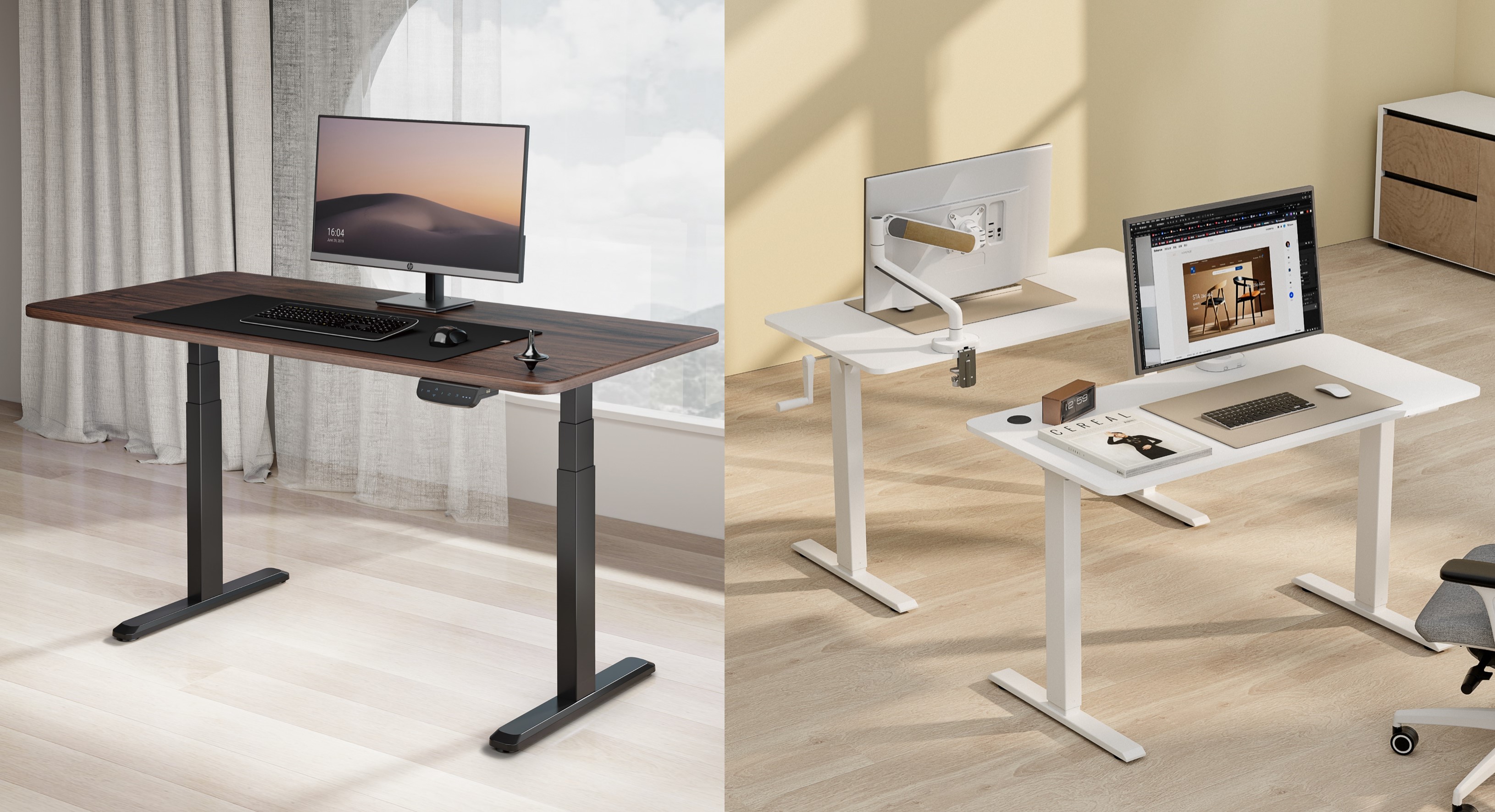Electric or Manual: Which Standing Desk is Right for You?
In the ever-evolving landscape of office furniture, standing desks have gained immense popularity for promoting a healthier and more dynamic work environment in the office or home. Both electric and manual standing desks are height adjustable and help with increasing productivity, so one crucial decision arises for individuals and businesses alike: electric or manual? In this article, we'll investigate the key differences between electric and manual sit-stand desks and explore the distinct advantages each option offers.
The Differences Between Electric and Manual Standing Desks
LUMI boasts a variety of adjustable standing desks at any price, including sit-stand desks and sit-stand workstations. All of them are manufactured with quality materials and passed strict tests to guarantee high-performance functionalities and long-life use.
Electric Standing Desks: Also known as motorized desks or adjustable height desks, are powered by electricity and operate with the assistance of one or multiple electric motors. The motor allows users to effortlessly adjust the desk's height with the push of a button or the touch of a control panel. The advanced electronic mechanism ensures a quick, smooth, and precise transition between sitting and standing positions.
Manual Standing Desks: Rely on a mechanical system for height adjustment such as crank handle activated and paddle lever activated. Users manually turn a crank or squeeze a hand lever to raise or lower the desk to their desired height. While manual desks lack the electronic components of their electric counterparts, they offer a straightforward and budget-friendly alternative.
Advantages of Electric Standing Desks
a. Ease of Adjustment
One of the primary advantages of electric standing desks is the effortless adjustment process. With a simple press of a button or touch of the screen, users can transition between sitting and standing positions without exerting physical effort. This convenience encourages regular changes in posture throughout the workday, promoting better ergonomics and reducing the risk of musculoskeletal issues.
b. Programmable Height Settings
Electric standing desks often come equipped with programmable height settings, allowing users to save their preferred desk heights. This feature is particularly beneficial in shared workspaces, as multiple users can easily switch between their personalized settings, fostering a seamless and user-friendly experience. By the way, click on How High Should a Standing Desk Be to get assistance for setting the proper height.
c. Smooth and Silent Operation
The electric motor in these desks ensures a smooth and silent transition, creating a disturbance-free work environment. This is especially advantageous in open offices, collaborative spaces, or night working environments where noise reduction is essential for maintaining productivity and focus.
d. Integration with Smart Devices
Many electric standing desks such as LUMI’s M06/M07-AI Series are designed to integrate with smart devices and wellness apps. This connectivity enables users to set reminders for posture changes, track standing time, and receive health-related notifications, contributing to a more holistic approach to well-being in the workplace.
e. Memory Settings and Reminders
Electric standing desks often feature memory settings that allow users to program and save their preferred desk heights. Additionally, some models come with built-in reminder features. Users can schedule reminders to prompt them to switch between sitting and standing positions, ensuring a consistent and healthy balance throughout the workday. This proactive approach to maintaining good ergonomic habits contributes to long-term health and well-being.
f. Contemporary Aesthetics
Electric standing desks often boast a sleek and modern design, adding a touch of sophistication to the office environment. The integration of advanced technology and high-quality materials enhances the overall aesthetic appeal, making these desks a stylish choice for contemporary workspaces.
Advantages of Manual Standing Desks
a. Cost-Effectiveness
One of the primary advantages of manual standing desks is their cost-effectiveness. These desks generally have a lower upfront cost compared to their electric counterparts, making them an attractive option for budget-conscious individuals and small businesses looking to invest in ergonomic furniture without breaking the bank.
b. No Dependence on Electricity
Manual standing desks operate without the need for electricity, offering a practical solution for spaces where access to power outlets may be limited. This can be especially beneficial in flexible or temporary work environments, such as co-working spaces or pop-up offices, where electrical infrastructure may not be readily available.
c. Durability and Reliability
With fewer electronic components, manual standing desks are often perceived as more durable and reliable. The absence of an electric motor eliminates the risk of motor malfunctions, ensuring a longer lifespan for the desk. This durability can be appealing for users looking for a low-maintenance and robust standing desk solution.
d. Environmentally Friendly
Manual standing desks are considered more environmentally friendly due to their lower energy consumption. With no reliance on electricity during height adjustments, these desks contribute to a reduced carbon footprint, aligning with the growing emphasis on sustainable and eco-friendly practices in the workplace.
e. User-Controlled Adjustment Speed
Users of manual standing desks have direct control over the speed at which they adjust the desk's height. Some individuals prefer the tactile experience of manually turning a crank or using a lever, allowing them to tailor the adjustment process to their comfort level. This manual control can be advantageous for those who appreciate a hands-on approach to desk customization.
How to Choose the Right Standing Desk?
Now that we've explored the differences and advantages of electric and manual standing desks, let's delve into essential factors to consider when making your decision. Choosing the right standing desk involves evaluating your unique needs, preferences, and workspace requirements. Here are three crucial aspects to consider:
1. Your Budget
One of the primary considerations when selecting a standing desk is your budget. Both electric and manual standing desks come with varying price points, and understanding your financial constraints is crucial. Electric standing desks often have a higher upfront cost due to their advanced features and electronic components. If you're on a tight budget, a manual standing desk can be a cost-effective alternative without compromising on the benefits of ergonomic design. Carefully weigh the upfront investment against the long-term benefits to find a standing desk that aligns with your financial considerations.
2. Self-disciplined/Heteronomous
Consider your personal work habits and discipline when deciding between electric and manual standing desks. If you prefer the convenience of effortlessly adjusting your desk with the push of a button and are likely to embrace technology-driven wellness features, an electric standing desk may be the right choice. On the other hand, if you appreciate a more hands-on and deliberate approach to height adjustments and don't mind the physical effort involved, a manual standing desk offers simplicity and a more direct connection with your workspace. Understanding your work style will help you choose a standing desk that complements your habits and enhances your overall work experience.
3. Room Setting
The physical setting of your workspace plays a crucial role in determining the most suitable standing desk for your needs. If your office or home workspace is limited in terms of electrical outlets or lacks easy access to power sources, a manual standing desk provides the flexibility to be placed anywhere without dependency on electricity. Additionally, if you frequently change your room setup or work in various locations, the portability and independence from the power requirements of a manual standing desk may be advantageous. Assess the spatial and electrical constraints of your workspace to ensure seamless integration of your chosen standing desk.
Conclusion
Choosing between an electric and a manual standing desk ultimately depends on individual preferences, budget considerations, and specific workspace requirements. Electric standing desks offer unparalleled convenience and advanced features, while manual standing desks provide a cost-effective and straightforward solution. Whether aiming for a high-tech, modern office or a practical, budget-friendly workspace, understanding the advantages of each option is crucial for making an informed decision that aligns with your ergonomic and operational needs.
One more word, LUMI also provides monitor arms, monitor risers, and a range of desk accessories to help create an ergonomic workspace, whether it's for a home office or a business office.





